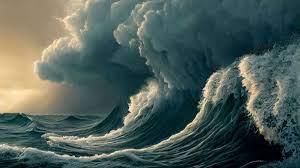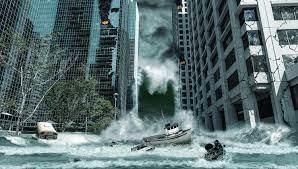Class 8 Exam > Class 8 Notes > General Knowledge Encyclopedia > What is a Tsunami?
What is a Tsunami? | General Knowledge Encyclopedia - Class 8 PDF Download
| Table of contents |

|
| Tsunami |

|
| Tsunami Facts for Kids |

|
| Most Deadly Tsunamis |

|
| What are tsunami safety rules? |

|
Tsunami
 A tsunami is an enormous wave or a sequence of waves triggered by a massive underwater earthquake or volcanic eruption. These phenomena arise due to movements in the Earth's crust.
A tsunami is an enormous wave or a sequence of waves triggered by a massive underwater earthquake or volcanic eruption. These phenomena arise due to movements in the Earth's crust.- When a powerful earthquake occurs beneath the ocean, a substantial amount of water is rapidly displaced. Initially, when this happens far from the shore, the tsunami waves do not exhibit a significant increase in height. However, as they approach the coastline, their speed and height intensify.
- As the tsunami waves reach the land, they can cause extensive damage. Some tsunamis have been widely reported in the media.
- Upon reaching the shoreline, several events take place. The trough of the tsunami (the lowest point beneath its crest) generally arrives first. As the tsunami reaches land, it draws coastal water towards the sea, temporarily exposing parts of the sea floor due to a vacuum effect.
- It is crucial to understand that a tsunami comprises multiple waves, forming a 'wave train.' Thus, one should not assume that the threat has passed after the initial wave. It is essential to await official confirmation from authorities that the situation is safe.
- Tsunamis are occasionally called tidal waves, but this term is not accurate from a technical standpoint, as they are not caused by tidal forces. Tidal waves are shallow water waves resulting from the gravitational interactions between the sun, the moon, and the earth. On the other hand, tsunamis are ocean waves generated by significant underwater earthquakes, volcanic eruptions, or landslides.
Tsunami Facts for Kids
Now you know what a tsunami is, we’ve collated some interesting tsunami facts around them for you and your class.
- Tsunami is a Japanese word that means 'Harbour Wave'.
- Approximately 80% of tsunamis happen inside the Pacific Ocean’s 'Ring of Fire'.
- An earthquake or volcano could cause a tsunami.
- Tsunamis can go about as fast as 500 miles (805 kilometres an hour), nearly the same speed as a jet plane.
- Tsunamis retain their energy, and this enables them to travel across vast oceans with very little energy loss.
- Hawaii is a high-risk area for tsunamis. People who live in Hawaii usually get 1 every year. They average a really severe tsunami almost every 7 years. Other vulnerable areas include Alaska and the Pacific Northwest in America.
- Scientists are able to precisely predict the time when a tsunami will reach nearly any location in the world. They can do this using calculations for the depth of the water, distance to travel, and the time the earthquake happened to cause the tsunami.
- If taken by a tsunami wave, the best thing you can do is grab a floating object and let the current carry you.
- Tsunami waves get bigger and stronger, so the first isn’t usually the strongest.
- Their waves can be as big as 100 feet!
- The 2004 Indian tsunami had a 9.0 magnitude epicentre on the Richter scale.
- That same Indian tsunami hit fourteen different countries from Thailand to Africa and killed around 250000 people.
- Scientists believe that a tsunami caused huge damage in Japan in the year 1700. They believe it had a magnitude of 9.
- A tsunami wave can be less than 30 centimetres tall!
Most Deadly Tsunamis

- Lisbon – 1755: The earthquake and tsunami almost totally destroyed Lisbon and had a death toll in Lisbon alone of between 10,000 and 100,000 people, making it one of the deadliest disasters in history.
- Italy - 1783: The Calabrian earthquakes were a sequence of five strong earthquakes that hit the region of Calabria, the first two of which produced tsunamis. The death toll lies in the range of 32,000 to 50,000 people.
- Italy – 1908: The Messina earthquake and tsunami took about 123,000 lives in Sicily and Calabria, southern Italy. The major cities of Messina and Reggio Calabria were almost completely destroyed.
- Sumatra, Indonesia – 2004: This Indian Ocean earthquake and tsunami was the most devastating of its kind in modern times, killing 230,000 people in 14 countries, and bringing waves of up to 30m high. It was the third-largest earthquake ever recorded, had the longest duration ever observed (8.3 to 10 minutes). It was so strong that it caused the entire planet to vibrate.
- Japan – 2011: At 2:46 pm, an 8.9 magnitude earthquake struck the northeast coast of Japan. The quake triggered a huge tsunami which swept inland. In places, the tsunami waves reached as far as 10k inland and entire towns virtually disappeared. Japan has the longest recorded history of tsunamis in the world.
What are tsunami safety rules?
- Tsunamis approaching the coast can be anticipated by sudden changes in coastal water levels, either rising or falling rapidly, and are often accompanied by a loud, roaring sound resembling that of a train or aircraft.
- If you observe these signs, it is crucial to immediately move inland to higher ground. Avoid getting distracted by the water's movement, as it can move much faster than you can.
- Remain in a safe location until an official "ALL CLEAR" notice is issued by the emergency services.
- Avoid staying in homes or buildings situated in low-lying coastal areas if there is a tsunami warning.
- In the absence of enough time to move inland or to higher ground, seek refuge on the upper floors of tall, multi-story, reinforced concrete hotels for safety.
- Refrain from going down to the beach to observe the tsunami, as a small wave at one beach can transform into a massive wave a few miles away.
- Stay updated and informed by listening to your local radio or television stations during a tsunami emergency.
The document What is a Tsunami? | General Knowledge Encyclopedia - Class 8 is a part of the Class 8 Course General Knowledge Encyclopedia.
All you need of Class 8 at this link: Class 8
|
30 videos|108 docs|27 tests
|
Related Searches



















